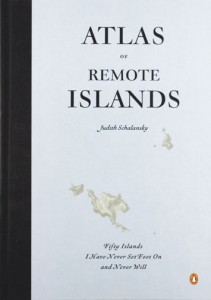 |
Judith Schalansky, Atlas of Remote Islands: 50 islands I never set foot on and never will. London: Penguin Books, 2010.
A friend who knows my current obsession with islands recently recommended this book to me. Schalansky has a degree in art history and is also trained as a designer. She won an award for the book’s design in Germany, where it was originally published in 2009. Most of the islands included in the book are uninhabitable. Each recto page features a beautifully understated topographical map, and each verso features a whimsical collection of facts, including strange stories about each island’s colonizers, prisoners and castaways. Schalansky was born in East Germany in 1980 and spent her childhood fantasizing about places she could only dream of going. For this project, she took that same armchair travel approach, doing her research by visiting historic archives and reading scientific reports. The result is not your typical fantasy of untainted paradises, but a commentary replete with ironic disdain for the romance of expedition and unrealistic expectations of exotic travel, which can be summed up in the name of one of the places she highlights: Disappointment Island.
|